"Look-Alike" Prints of the Early "Shin-Hanga" Era

Hasui's 1933 "Kiyomizu Temple, Kyoto" print alongside a "Look-Alike" Print (ca1930's)
"Look-Alike" Prints -- OK, What's the Story??
To collectors of Japanese woodblock prints of the early 1920's/30's "shin-hanga" era, there are occasionally encountered
“variant” designs...... or what we will choose to call in this article "look-alike" prints. In some cases these are virtually exact
"look-alikes," and in other cases simply prints which are oddly and oftentimes strikingly similar. Various descriptions have
been used to describe these prints, including the harsh term "plagiarism" and the more polite term of "variant design." In any case, whatever terminology
one uses to describe these prints, they do provide a fascinating study.
Marc Kahn has already presented a scholarly and well-documented discussion of the seemingly widespread "duplication" of a good
number of prints done by the artist Shotei (TAKAHASHI Hiroaki, 1871-1945) during this period, so we won't attempt to recover this same material
here. (Readers not already familiar with Marc's "Shotei.com" website will enjoy his coverage of
the "Shotei examples" he's highlighted in an article titled
"Variant print designs: post-earthquake restrikes or plagiarism?")
It is interesting to note that in nearly all cases, publishers who choose to produced "look-alike" prints clearly appeared to take seemingly
deliberate efforts to make their prints look in some way "different." That is to say, we seldom seem to encounter "exact copies"--instead,
we usually find that some "elements" of the original print have been either changed, or in some cases omitted.
Japanese Copyright Laws
We do know that various publishers of this early "shin-hanga" period did incorporate various "copyright statements" into the margins of
their prints. Watanabe Publisher, in particular, included
"copyright wording" within many of their earlier "publisher's seals" of the 1929-45 period, with most of their various
"oblong publisher's seals" containing some "copyright language" (their "C-seal" reads simply "Hanken Shoyu Watanabe Shozaburo," or
"Copyright owned by Watanabe Shozaburo," while their "D-seal" is somewhat more explicit, as it reads "Hanken Shoyu Fukyo
Mosha Watanabe Shozaburo," or "Copyrighted--No trace or copy without permission of Watanabe Shozaburo").
In a similiar manner, a great many of the prints produced by
Doi Publisher during this same early "shin-hanga" period also
incorporated "copyright wording" into their margins. Written vertically within the vertical boxes of their margins, we see
the easily recognizable "four kanji character" wording of
"Hanken Shoyu" ("han-ken-sho-ya"), which again means simply "copyright owned by," alongside the slightly different various
"publishing names" used by Doi during this period.
Hence--although we do NOT claim to be familiar with Japanese copyright laws of this period--the body of evidence that we continue to encounter on an
ongoing basis indicates that there was apparently "enough teeth" in Japanese law (at least in most cases) to adequately punish or prevent outright
copies from being made. That said, our common sense observations have therefore led us to believe that "as long as" adequate and
observable differences were incorporated into the copied print's design, it was apparently then not considered to be a "copy."
Yes, A Few "Exact" Copies DO Exist.....
Admittedly, a couple of blatantly duplicate copies of well-known Japanese prints DO exist, one of which has already been
discussed in our recent Ukiyoe-Gallery.com article,
"The 91-Percent Sized "Willow Bridge" Print by Koson," and
is pictured just below.

Slightly SMALLER (left) "Willow Bridge" Print
and Koson's Original "Willow Bridge" (1927)
There do exist, of course, a few other examples of seemingly "exact copies" having been made of popular prints. (One, which is a
very well-known and widely sought-after Hasui print(!!) and will soon be the topic of an upcoming Ukiyoe-Gallery article.)
However, at least in these few cases of "exact copies" with which we are familiar, it seems
that these publishers perhaps "got around the law" by a different means--by incorporating SIZE differences into these prints.
Hence, although these prints do indeed appear to be exact duplicates with respect to "image," they were nevertheless clearly
"different" with respect to size.
Why "Look-Alike" Prints Exist
The obvious and easy answer (and motivation) behind the production of "look-alike" prints is simply that of profiting from production and
sale of what had been observed to be a successful image on the part of their publishing competitors. The Japanese have long been
known since the Meiji Revolution to be successful adaptors to change in their collective march toward modernization--and much
of this movement was aimed toward western tastes and ideals.
In their dealings with the "west," Japanese businessmen learned
decades ago to be very attentive to the needs, tastes, and desires of both European and American markets. Hence, as publishers
of art--which was primarily produced to satisfy the tastes of the western markets--these publishers paid close attention to "what sold best"
and what did not. Therefore, prints which were produced as "look-alikes" were clearly made to simply to capitalize
on the popularity of what were obviously very popular and very well-selling prints of the 1920's and 30's.
Valuing Such "Variant" (or "Look-Alike") Designs
Finally, before moving on to examine a few such examples of "look-alike" prints, we again wish to firmly reiterate a
previously made point. That is, we as authors wish to emphasize that our continued study of “variant” or perhaps “copied” designs
is in NO way intended to diminish or in any way “place a lower value” on such prints which are believed to have been produced later
as copies.
From our
perspective as collectors of Japanese prints, ALL woodblocks are viewed as being magnificent works of art and are deserving
of our study and admiration. Indeed, it can be argued that at least in some cases, “variant designs” can be even MORE highly
sought-after due to their rarity since in many cases they are seldom encountered. At the very least, they certainly command our
attention (and respect) for the “unique perspective” which they offer us in our study of Japanese prints.
OK--with that background discussion, let's now move on to our first example.
Examples of "Look-Alike" Prints
Hasui's 1933 "Kiyomizu Temple, Kyoto" Print and a "Look-Alike" Print
As our first example, we will now present a recently encountered and very interesting "look-alike" copy of Hasui's 1933 "Kiyomizu
Temple, Kyoto" Print. This particular print has recently come to us, included in a selection of prints that we have recently
acquired from the Estate of Robert O. Muller. This strikingly similar horizontal format "look-alike" print is seen just below, set to the right of
Hasui's original 1933 "Kiyomizu Temple, Kyoto" print.

Hasui's 1933 "Kiyomizu Temple, Kyoto" Print alongside a "Look-Alike" Print (ca1930's)
(As a footnote, we will add that although some 4,000 of the Robert O. Muller
"Collection" were indeed donated to the Slacker Gallery of the Smithsonain Institution--this large donation clearly did not, in
fact, include "all" of Bob's prints. Hence, a random sampling of "duplicate" prints are now finding their way onto the
marketplace--many of which appear to be seldom seen, and a few of which appear to be quite unique.)
To us at least, this first example seems quite unique--a previously unseen (at least to our eyes) "look-alike" print that literally jumped out
at us when we first viewed it. It was immediately "recognized" as having been composed from Hasui's well-known "Kiyomizu Temple,
Kyoto" print which was produced in 1933. We purchased it immediately, wanting to have it "in-hand" for our closer study.
Many "Look-Alike" Prints Lack Signatures or Seals.....
As seems to be the case in many of these early 1900's "look-alike" prints, many are found have been produced WITHOUT any artist's
"signature or seals" appearing on them. Additionally, many are also found to lack any publisher's information as well. This makes
sense, because if their production was perhaps questionable (legally) at the time, the lack of any printed publisher's information
on the print would certainly have likely made it more difficult to determine (or prove) who had actually produced the print.
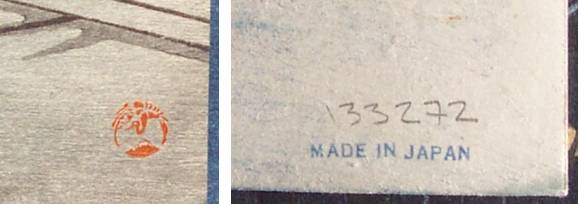
Seals found on our "Look-Alike Kiyomizu" Print (ca1930's)
In this case, our newly received "Kiyomizu Look-Alike" print DID indeed turn out to bear only two small markings (seen above). Recognizable
in the print's lower right image was the red, round "publisher's seal" of Shima Art Company, a Tokyo/New York publisher active in
the 1930's (more specifically, a New York-based distribution company whose prints were, of course, produced in Tokyo).
And then, on the print's verso, was found simply a little "Made in Japan" stamping alongside a dealer's/collector's penciled number. Beyond
this, we remain clueless as to "who" the artist/designer of this print was.
Having a Closer Look.....
Next, zooming in for a closer look, we were quite amazed at how striking similar these two prints really were. Although clearly
not "exactly" the same, nearly all of the architectural details seen in both prints were virtually identical. About the only obvious differences were
that the "look-alike" print had omitted the man standing on the balcony, the background and distant mountains had been changed
somewhat, and the "two stars" seen overhead had been moved somewhat.
It quickly became clear from our examination that although the "look-alike" print had NOT been traced from the original, nevertheless
it was obviously in many ways a very close copy.
Finally, of course to the casual observer, the biggest difference was that Hasui's original "Kiyomizu Temple, Kyoto" print was produced
in a vertical format, while the "Look-Alike Kiyomizu" print was done in a horizontal or landscape format.

Detail of Hasui's 1933 "Kiyomizu Temple, Kyoto" Print and our "Look-Alike" Print
Overlaying the Two Prints
Next, wondering just "how close" these two prints really were......and wanting to confirm that the "look-alike" print had not been
traced from the Hasui original, we then physically overlaid the two prints to check for "fit," as seen just below. Indeed, this
quick check did confirm how really close these two prints were as to the scaling and physical dimensions of the temple and balcony.
However, although very close, they were clearly proven to not be the same.
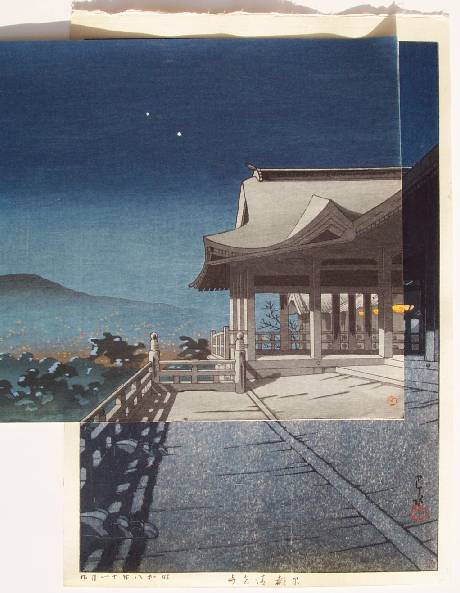
"Look-Alike" Print Laid on TOP of Hasui's 1933 "Kiyomizu Temple, Kyoto" Print
It quickly became clear from our examination that although the "look-alike" print had NOT been traced from the original, nevertheless
it was obviously in many ways a very close copy.
Comparing the Technical Quality of the Two Prints
Finally, in an honest attempt to demonstrate to our readers the technical quality with which many of these such "look-alike" prints of the
early 1900's were produced, we decided to offer an EVEN CLOSER look at the "detailing" seen in these two prints. We think many of
our readers will likely be quite surprised to see the extreme care with which many of these "copies" were produced.
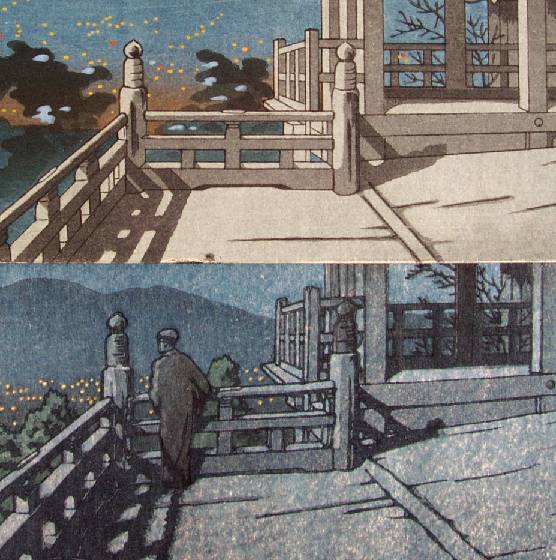
An Extreme Close-up of our "Look-Alike" Print (top) and Hasui's 1933 "Kiyomizu Temple, Kyoto" Print (below)
As can be readily seen in this final close-up examination of both prints (seen above), clearly the "fine detailing" of the
"look-alike" (top) print is actually SUPERIOR in quality to the quality of carving seen in the original Hasui print (seen below).
With this closer look, the carved lines are seen to be sharper and more well defined in this later "look-alike" print--even we were a bit surprised upon
making this observation!!
Although this is not always the case, on balance we have found that the care and efforts put into the production of various
"look-alike" prints of this period were considerable. In other words, they were not quickly and cheaply made to simply fulfill
the needs of a hungry foreign market. Clearly, much technical excellence and considerable effort was expended in their production.
Koitsu's 1939 "Kagurazaka" Print and Noeut's EARLIER 1937 "Kagurazaka" Print
As our second example, we will now present what to many of our readers will come as a surprise to them. The very well-known Koitsu "Kagurazaka
at Ushigome" print with which many viewers are well familiar, was in fact, a COPY of a very similar print of the same title
("Kagurazaka at Ushigome") done by the French artist, Noel Nouet done 2 years EARLIER in 1937. Although this may not be of the
usual type of "look-alike" prints that we will highlight, we thought we should set the record straight on this highly
recognizable image that most viewers and collectors assume to be a "Koitsu-designed" image.
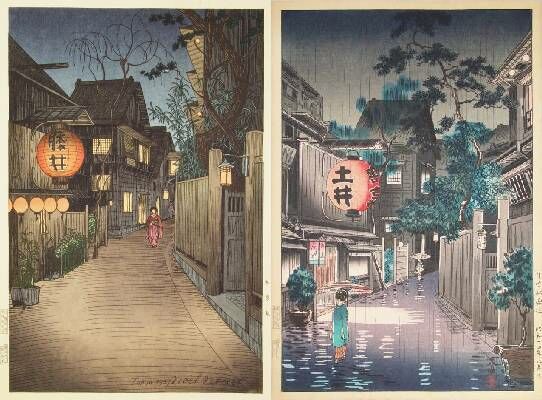
Nouet's 1937 "Kagurazaka at Ushigome" Print alongside
Koitsu's 1939 "Kagurazaka at Ushigome" Print
There were, of course, a handful of "western printmakers" who lived and worked in Japan during the early 1900's "shin-hanga" era.
Included were the now familiar names of such artists as Paul Jacoulet, Charles Bartlett, Elizabeth Keith, and Noel Nouet, to name
just a few. Most were--like their Japanese counterparts--simply artists, who then left the actual carving and printing of their
designs to be done by associations through their publishers.
One such artist was the Frenchman, Noel Nouet, who first came to Japan in 1926 as a French teacher. Although little is seemingly
known of Nouet's earlier years, we do know that in 1935 he began an association with the Doi Publishing House. As a result, over the
period from 1935 to 1937 a total of 25 prints were designed by Nouet, with a final/single 26th print then being later published in 1950.
Twenty-four of Nouet's prints were prepared by Doi Publisher as a series titled "Scenes of Tokyo, Twenty-four views" (in Japanese, "Tokyo fukkei
zen nijuyon mai,") of which our readers can learn more via our article:
"The Woodblock Prints of Noel Nouet." Nouet remained many years in
Japan, in fact, witnessing and recording much of the wartime damage done to Tokyo in a little 1946 "sketchbook" titled and later
published as "Tokyo: Fifty Sketches." Nouet then finally left Japan in 1962.
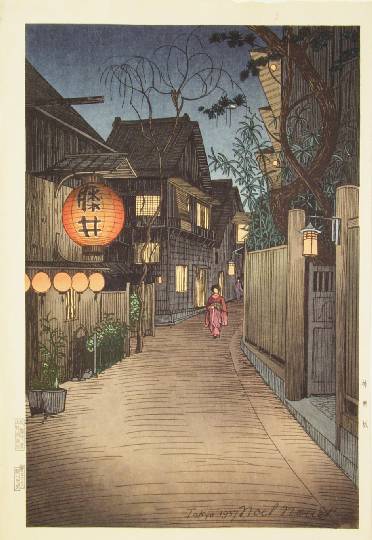
Nouet's 1937 "Kagurazaka at Ushigome" Print
Returning now to the print design which is the topic of this sub-article, we see Nouet's 1937 "Kagurazaka at Ushigome" print just
above. Without saying more, we wish to simply point out that it was indeed Nouet who FIRST designed this famous image--apparently
a full two years before the more well known Koitsu image then later appeared.
Like all of Nouet's print designs, each was designed and based on his original pen and ink sketches. These highly
detailed and crisply drawn images speak of a style which was distinctively that of "Nouet." The actual "line-work" which was
subsequently reproduced by Doi's craftsmen is remarkable--the crisp lines and detailing done in Nouet's sketches appear to have
been faithfully captured. Although we cannot say for certain (and denied by Doi!!), we believe that these various prints'
"key-blocks" may have actually have been done via "zinc-plate." Of course, all of the additional blocks required to print each print have
certainly nevertheless been carved from traditional cherrywood blocks. Readers wishing to learn a bit more can review our previous
article, "Noel Nouet - A French Poet-Artist in Japan."

Koitsu's 1939 "Kagurazaka at Ushigome" Print
Next then, just above, we now turn to Koitsu's 1939 version of the strikingly similar "Kagurazaka at Ushigome" print. Althought we will of
course never know for sure, it is certainly possible that Koitsu himself may have in fact never even visited this Tokyo location.
In any case, it appears most probable that Doi simply suggested to Koitsu that he might as well design a similar image of this
nostalgic and atmospheric scene. Without doubt, one can at least be certain that within the Doi Publishing House, copies of Nouet's two
year earlier design were certainly readily available and likely laying about. Whatever the case, both prints are indeed delightful
depictions of "nighttime lighting" in the
style of which Koitsu became so well known. (However, we wish to point out that such "lighting effects" are actually more often
the result of the skillfully trained printers and achieved via careful inking known as "bokashi" shading.)
A few additional words should perhaps be said of Koitsu as an artist. Certainly more well known than Nouet, Koitsu was of course
trained in the traditional style of most Japanese woodblock artists and received much of his early training (beginning at the age of
15, and lasting for 19 years) under the watchful eyes of Meiji artist, Kiyochika KOBAYASHI (1847-1915). Kiyochika was himself
highly praised for his skillful "depictions of light," so of course much of Koitsu's skills can be attributed to his studies under
Kiyochika. Known earliest for his woodblock prints of the 1894-95 Sino-Japanese War, Koitsu later established lasting associations
with both Doi and Watanabe Publishers. Between 1933 and 1941, he is known to have produced at least 56 various designs via the Doi
Publishing House.
Conclusion
The above two examples of a "look-alike" print has been only the first couple of what is planned to be a series of such prints that we will
continue to highlight here in our Ukiyoe-Gallery.com articles. Additional interesting examples have already "caught our eyes,"
and will soon be presented for our reader's study and enjoyment.
Although certainly not earth-shaking--and admittedly lacking in hard, factual knowledge--we nevertheless hope that our shared
observations, thoughts, and opinions will be of interest to our readership.
Certainly, with the passage of time, many of the final answers may never be fully known. Still, it is at times enjoyable to
speculate as to the origins of such prints from the early "shin-hanga" era.
Literature (and print) sources used in preparation of this article include:
Above documented prints courtesty of: Ukiyoe-Gallery
"Guide to Modern Japanese Woodblock Prints: 1900-1975", by Helen Merritt and Nanako Yamada, University of Hawaii Press, Honolulu, ISBN 0-8248-1732-X
"Kawase Hasui -- The Complete Woodblock Prints", by Kendall H. Brown & Shoichiro Watanabe, Hotei (KIT) Publishing, Netherlands, ISBN 90-74822-46-0
(c) Thomas Crossland and Dr. Andreas Grund, November, 2003
Gallery
Terms
Ordering
About Us
We Buy Prints
Library










